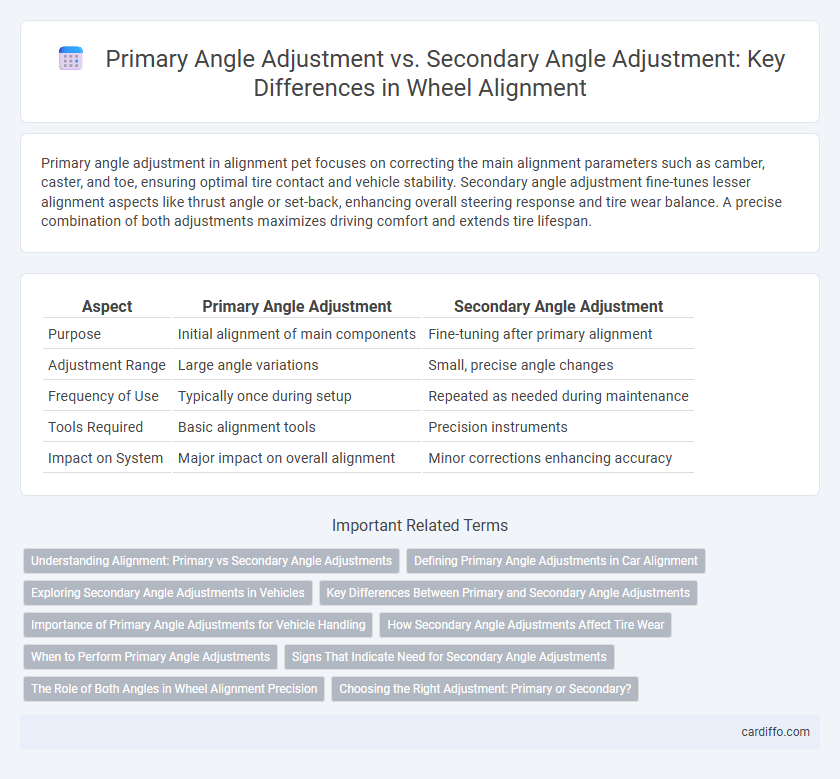Primary angle adjustment in alignment pet focuses on correcting the main alignment parameters such as camber, caster, and toe, ensuring optimal tire contact and vehicle stability. Secondary angle adjustment fine-tunes lesser alignment aspects like thrust angle or set-back, enhancing overall steering response and tire wear balance. A precise combination of both adjustments maximizes driving comfort and extends tire lifespan.
Table of Comparison
| Aspect | Primary Angle Adjustment | Secondary Angle Adjustment |
|---|---|---|
| Purpose | Initial alignment of main components | Fine-tuning after primary alignment |
| Adjustment Range | Large angle variations | Small, precise angle changes |
| Frequency of Use | Typically once during setup | Repeated as needed during maintenance |
| Tools Required | Basic alignment tools | Precision instruments |
| Impact on System | Major impact on overall alignment | Minor corrections enhancing accuracy |
Understanding Alignment: Primary vs Secondary Angle Adjustments
Primary angle adjustment targets the camber, caster, and toe settings on the front wheels to ensure proper tire contact and vehicle handling. Secondary angle adjustment fine-tunes parameters like thrust angle and rear wheel alignment to maintain overall stability and correct tracking. Both adjustments are critical for optimizing vehicle alignment, enhancing tire wear, and improving safety on the road.
Defining Primary Angle Adjustments in Car Alignment
Primary angle adjustments in car alignment refer to the fundamental settings of the camber, caster, and toe angles, which directly influence tire contact, steering response, and overall vehicle handling. Precise calibration of these angles ensures optimal tire wear and stability, forming the basis for secondary angle adjustments like thrust angle alignment. Accurate primary angle adjustment is essential for maintaining proper alignment geometry and enhancing driving safety.
Exploring Secondary Angle Adjustments in Vehicles
Secondary angle adjustments in vehicle alignment, encompassing camber, caster, and toe settings, play a crucial role in optimizing tire contact with the road and enhancing handling performance. Unlike primary angle adjustments that focus on basic wheel alignment, refining secondary angles improves cornering stability, reduces tire wear, and ensures precise steering response. Advanced alignment systems utilize precise measurements and adjustments to these secondary angles, resulting in enhanced vehicle safety and ride comfort.
Key Differences Between Primary and Secondary Angle Adjustments
Primary angle adjustment primarily involves altering the camber and caster angles to ensure optimal tire contact and steering stability, directly influencing vehicle handling and tire wear. Secondary angle adjustment focuses on the toe angle, fine-tuning wheel alignment to enhance directional control and minimize tire scrubbing during motion. The key difference lies in the impact scope: primary adjustments set fundamental suspension geometry while secondary adjustments refine wheel positioning for precise driving dynamics.
Importance of Primary Angle Adjustments for Vehicle Handling
Primary angle adjustments, including camber, caster, and toe, are crucial for optimal vehicle handling, directly affecting tire contact with the road and steering responsiveness. Proper camber alignment ensures maximum tire grip during turns, while accurate caster settings enhance straight-line stability and steering feel. Secondary angle adjustments fine-tune alignment but cannot compensate for incorrect primary angles, making primary adjustments essential for safety and performance.
How Secondary Angle Adjustments Affect Tire Wear
Secondary angle adjustments, such as toe and thrust angle, significantly impact tire wear by altering the direction and pressure distribution on the tire tread during driving. Incorrect secondary angles cause excessive tire scrubbing and uneven tread wear, leading to premature tire replacement and reduced fuel efficiency. Properly calibrated secondary angles extend tire life and improve vehicle handling stability.
When to Perform Primary Angle Adjustments
Primary angle adjustments should be performed when the initial wheel alignment settings fall outside the manufacturer's specified range, directly affecting the vehicle's tracking and tire wear. This adjustment is critical during suspension component replacements, steering system repairs, or after noticeable handling issues like pulling or uneven tire wear. Performing primary angle adjustments first ensures the foundation for secondary adjustments, such as camber and caster, is accurate for optimal alignment results.
Signs That Indicate Need for Secondary Angle Adjustments
Uneven tire wear patterns, especially feathering or cupping, often signal the need for secondary angle adjustments in vehicle alignment. Persistent steering pull or a crooked steering wheel despite primary angle corrections further indicate secondary alignment issues. These signs suggest misalignment in camber or caster angles that primary adjustments alone cannot resolve.
The Role of Both Angles in Wheel Alignment Precision
Primary angle adjustment, consisting of camber, caster, and toe, directly influences the vehicle's tire contact with the road, ensuring optimal traction and minimizing uneven tire wear. Secondary angle adjustment fine-tunes the alignment by addressing parameters such as thrust angle and steering axis inclination, enhancing directional stability and steering response. Together, these angles harmonize to maximize wheel alignment precision, improve vehicle handling, and extend tire longevity.
Choosing the Right Adjustment: Primary or Secondary?
Choosing between primary angle adjustment and secondary angle adjustment depends on the specific alignment issue and vehicle design. Primary angle adjustments, such as camber, caster, and toe, directly impact tire contact and handling, making them essential for correcting major alignment problems. Secondary angle adjustments fine-tune the alignment settings for optimal performance and tire wear, often addressing subtle issues that primary adjustments cannot fully resolve.
Primary Angle Adjustment vs Secondary Angle Adjustment Infographic

 cardiffo.com
cardiffo.com